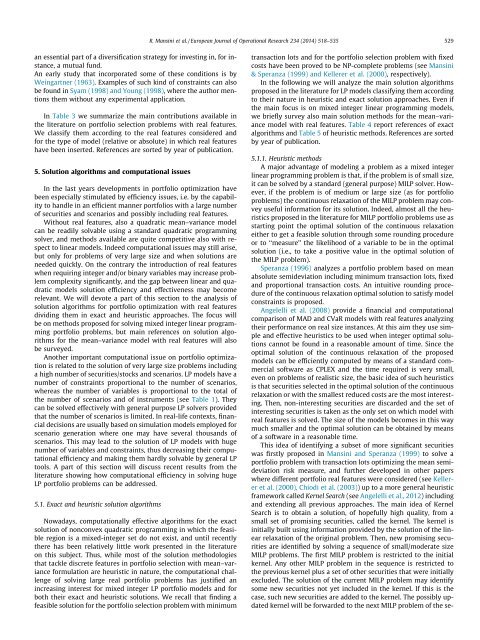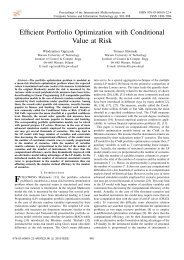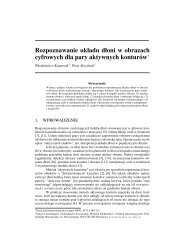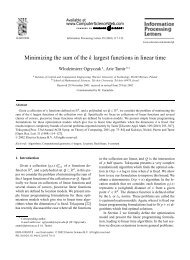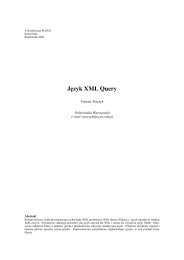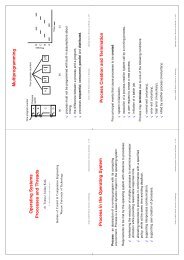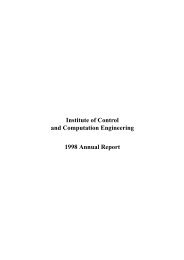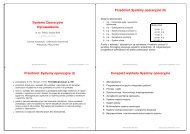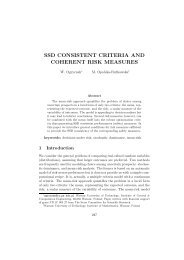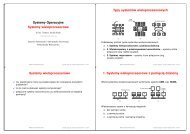Twenty Years of Linear Programming Based Portfolio Optimization
Twenty Years of Linear Programming Based Portfolio Optimization
Twenty Years of Linear Programming Based Portfolio Optimization
You also want an ePaper? Increase the reach of your titles
YUMPU automatically turns print PDFs into web optimized ePapers that Google loves.
R. Mansini et al. / European Journal <strong>of</strong> Operational Research 234 (2014) 518–535 529<br />
an essential part <strong>of</strong> a diversification strategy for investing in, for instance,<br />
a mutual fund.<br />
An early study that incorporated some <strong>of</strong> these conditions is by<br />
Weingartner (1963). Examples <strong>of</strong> such kind <strong>of</strong> constraints can also<br />
be found in Syam (1998) and Young (1998), where the author mentions<br />
them without any experimental application.<br />
In Table 3 we summarize the main contributions available in<br />
the literature on portfolio selection problems with real features.<br />
We classify them according to the real features considered and<br />
for the type <strong>of</strong> model (relative or absolute) in which real features<br />
have been inserted. References are sorted by year <strong>of</strong> publication.<br />
5. Solution algorithms and computational issues<br />
In the last years developments in portfolio optimization have<br />
been especially stimulated by efficiency issues, i.e. by the capability<br />
to handle in an efficient manner portfolios with a large number<br />
<strong>of</strong> securities and scenarios and possibly including real features.<br />
Without real features, also a quadratic mean–variance model<br />
can be readily solvable using a standard quadratic programming<br />
solver, and methods available are quite competitive also with respect<br />
to linear models. Indeed computational issues may still arise,<br />
but only for problems <strong>of</strong> very large size and when solutions are<br />
needed quickly. On the contrary the introduction <strong>of</strong> real features<br />
when requiring integer and/or binary variables may increase problem<br />
complexity significantly, and the gap between linear and quadratic<br />
models solution efficiency and effectiveness may become<br />
relevant. We will devote a part <strong>of</strong> this section to the analysis <strong>of</strong><br />
solution algorithms for portfolio optimization with real features<br />
dividing them in exact and heuristic approaches. The focus will<br />
be on methods proposed for solving mixed integer linear programming<br />
portfolio problems, but main references on solution algorithms<br />
for the mean–variance model with real features will also<br />
be surveyed.<br />
Another important computational issue on portfolio optimization<br />
is related to the solution <strong>of</strong> very large size problems including<br />
a high number <strong>of</strong> securities/stocks and scenarios. LP models have a<br />
number <strong>of</strong> constraints proportional to the number <strong>of</strong> scenarios,<br />
whereas the number <strong>of</strong> variables is proportional to the total <strong>of</strong><br />
the number <strong>of</strong> scenarios and <strong>of</strong> instruments (see Table 1). They<br />
can be solved effectively with general purpose LP solvers provided<br />
that the number <strong>of</strong> scenarios is limited. In real-life contexts, financial<br />
decisions are usually based on simulation models employed for<br />
scenario generation where one may have several thousands <strong>of</strong><br />
scenarios. This may lead to the solution <strong>of</strong> LP models with huge<br />
number <strong>of</strong> variables and constraints, thus decreasing their computational<br />
efficiency and making them hardly solvable by general LP<br />
tools. A part <strong>of</strong> this section will discuss recent results from the<br />
literature showing how computational efficiency in solving huge<br />
LP portfolio problems can be addressed.<br />
5.1. Exact and heuristic solution algorithms<br />
Nowadays, computationally effective algorithms for the exact<br />
solution <strong>of</strong> nonconvex quadratic programming in which the feasible<br />
region is a mixed-integer set do not exist, and until recently<br />
there has been relatively little work presented in the literature<br />
on this subject. Thus, while most <strong>of</strong> the solution methodologies<br />
that tackle discrete features in portfolio selection with mean–variance<br />
formulation are heuristic in nature, the computational challenge<br />
<strong>of</strong> solving large real portfolio problems has justified an<br />
increasing interest for mixed integer LP portfolio models and for<br />
both their exact and heuristic solutions. We recall that finding a<br />
feasible solution for the portfolio selection problem with minimum<br />
transaction lots and for the portfolio selection problem with fixed<br />
costs have been proved to be NP-complete problems (see Mansini<br />
& Speranza (1999) and Kellerer et al. (2000), respectively).<br />
In the following we will analyze the main solution algorithms<br />
proposed in the literature for LP models classifying them according<br />
to their nature in heuristic and exact solution approaches. Even if<br />
the main focus is on mixed integer linear programming models,<br />
we briefly survey also main solution methods for the mean–variance<br />
model with real features. Table 4 report references <strong>of</strong> exact<br />
algorithms and Table 5 <strong>of</strong> heuristic methods. References are sorted<br />
by year <strong>of</strong> publication.<br />
5.1.1. Heuristic methods<br />
A major advantage <strong>of</strong> modeling a problem as a mixed integer<br />
linear programming problem is that, if the problem is <strong>of</strong> small size,<br />
it can be solved by a standard (general purpose) MILP solver. However,<br />
if the problem is <strong>of</strong> medium or large size (as for portfolio<br />
problems) the continuous relaxation <strong>of</strong> the MILP problem may convey<br />
useful information for its solution. Indeed, almost all the heuristics<br />
proposed in the literature for MILP portfolio problems use as<br />
starting point the optimal solution <strong>of</strong> the continuous relaxation<br />
either to get a feasible solution through some rounding procedure<br />
or to ‘‘measure’’ the likelihood <strong>of</strong> a variable to be in the optimal<br />
solution (i.e., to take a positive value in the optimal solution <strong>of</strong><br />
the MILP problem).<br />
Speranza (1996) analyzes a portfolio problem based on mean<br />
absolute semideviation including minimum transaction lots, fixed<br />
and proportional transaction costs. An intuitive rounding procedure<br />
<strong>of</strong> the continuous relaxation optimal solution to satisfy model<br />
constraints is proposed.<br />
Angelelli et al. (2008) provide a financial and computational<br />
comparison <strong>of</strong> MAD and CVaR models with real features analyzing<br />
their performance on real size instances. At this aim they use simple<br />
and effective heuristics to be used when integer optimal solutions<br />
cannot be found in a reasonable amount <strong>of</strong> time. Since the<br />
optimal solution <strong>of</strong> the continuous relaxation <strong>of</strong> the proposed<br />
models can be efficiently computed by means <strong>of</strong> a standard commercial<br />
s<strong>of</strong>tware as CPLEX and the time required is very small,<br />
even on problems <strong>of</strong> realistic size, the basic idea <strong>of</strong> such heuristics<br />
is that securities selected in the optimal solution <strong>of</strong> the continuous<br />
relaxation or with the smallest reduced costs are the most interesting.<br />
Then, non-interesting securities are discarded and the set <strong>of</strong><br />
interesting securities is taken as the only set on which model with<br />
real features is solved. The size <strong>of</strong> the models becomes in this way<br />
much smaller and the optimal solution can be obtained by means<br />
<strong>of</strong> a s<strong>of</strong>tware in a reasonable time.<br />
This idea <strong>of</strong> identifying a subset <strong>of</strong> more significant securities<br />
was firstly proposed in Mansini and Speranza (1999) to solve a<br />
portfolio problem with transaction lots optimizing the mean semideviation<br />
risk measure, and further developed in other papers<br />
where different portfolio real features were considered (see Kellerer<br />
et al. (2000), Chiodi et al. (2003)) up to a more general heuristic<br />
framework called Kernel Search (see Angelelli et al., 2012) including<br />
and extending all previous approaches. The main idea <strong>of</strong> Kernel<br />
Search is to obtain a solution, <strong>of</strong> hopefully high quality, from a<br />
small set <strong>of</strong> promising securities, called the kernel. The kernel is<br />
initially built using information provided by the solution <strong>of</strong> the linear<br />
relaxation <strong>of</strong> the original problem. Then, new promising securities<br />
are identified by solving a sequence <strong>of</strong> small/moderate size<br />
MILP problems. The first MILP problem is restricted to the initial<br />
kernel. Any other MILP problem in the sequence is restricted to<br />
the previous kernel plus a set <strong>of</strong> other securities that were initially<br />
excluded. The solution <strong>of</strong> the current MILP problem may identify<br />
some new securities not yet included in the kernel. If this is the<br />
case, such new securities are added to the kernel. The possibly updated<br />
kernel will be forwarded to the next MILP problem <strong>of</strong> the se-


